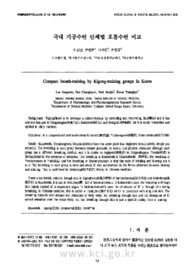

PARTNER
검증된 파트너 제휴사 자료
국내 기공수련 단체별 호흡수련 비교 (Compare breath-training by Kigong-training groups in Korea)
한국학술지에서 제공하는 국내 최고 수준의 학술 데이터베이스를 통해 다양한 논문과 학술지 정보를 만나보세요.
11 페이지
최초등록일 2025.05.10
최종저작일
2008.04

-
미리보기
서지정보
· 발행기관 : 한국한의학연구원
· 수록지 정보 : 한국한의학연구원논문집 / 14권 / 1호 / 73 ~ 83페이지
· 저자명 : 이상남, 한창현, 박수진, 권영규
초록
Background : Kigong($.J1]) is to develope a nature-therapy by controling and recovering Jinki(!l@;$.) and it has common features in Yangsaengbeob(fE!:.1.H Doinbeob(i!i][t!) and Jeongkisin(~$.jji$), but it is rarely researched and applied in clinic examine.
Objectives: it is compared and contrasted among KukseondO(~iR@, Yeonjeongwon(1jJf~~, SeokmunhoheubC5F9iPJL!1&). Result: Kukseondo, Yeonjeongwon, Seokmunhoheub have the same point that beginners breath slowly, deeply and naturally. The breathing in each group becomes deeper gradually by mental and physical relaxation although each group has a different breathing method, and it is similar to Jogigyeol(waJ$.~) in Dongeuibogam. Ywasik(~~) is distinguished by the presence of sensation. The breathing in Kukseondo is Yidanhoheub(= l'9:iPJL!1&), the breathing in Yeonjeongwon is Yugi(fij$.) and the breathing in Seokmunhoheub is that the ratio of inhaling and blowing are 6 to 4. The breathing in each group is deep and small, Ki also accumulates in the Below-abdomen between blowing and inhaling. This is confirmed by Sinjunapgi(~:Ek?l$.) theory in Oriental-medicine.
There is the breath, which is through skin, in Kigonghoheub($.]LiPJL!1&) of Samhabdanbeop(= ~ftt!) and Jolidanbeop(~ IlI1.ftt!) in Kukseondo, it is also in Gwiilbeop(i'i-t!) of Seokmunhoheub. In Kukseondo's case, the breathing is through skin mainly instead of a respiratory organ. In Seokmunhoheub's case, the circulation of Ki is through skin during breathing. In Oriental-medicine, this is called as Pyejupimo(IfrIj::t1t=€) which is connected with lung and skin. The breathing coincide with tension and relaxation of body while the breathing through skin and the absorption of Ki spread sensation over the whole body, but the breathing through skin is just a specific ability from a training.영어초록
Background : Kigong($.J1]) is to develope a nature-therapy by controling and recovering Jinki(!l@;$.) and it has common features in Yangsaengbeob(fE!:.1.H Doinbeob(i!i][t!) and Jeongkisin(~$.jji$), but it is rarely researched and applied in clinic examine.
Objectives: it is compared and contrasted among KukseondO(~iR@, Yeonjeongwon(1jJf~~, SeokmunhoheubC5F9iPJL!1&). Result: Kukseondo, Yeonjeongwon, Seokmunhoheub have the same point that beginners breath slowly, deeply and naturally. The breathing in each group becomes deeper gradually by mental and physical relaxation although each group has a different breathing method, and it is similar to Jogigyeol(waJ$.~) in Dongeuibogam. Ywasik(~~) is distinguished by the presence of sensation. The breathing in Kukseondo is Yidanhoheub(= l'9:iPJL!1&), the breathing in Yeonjeongwon is Yugi(fij$.) and the breathing in Seokmunhoheub is that the ratio of inhaling and blowing are 6 to 4. The breathing in each group is deep and small, Ki also accumulates in the Below-abdomen between blowing and inhaling. This is confirmed by Sinjunapgi(~:Ek?l$.) theory in Oriental-medicine.
There is the breath, which is through skin, in Kigonghoheub($.]LiPJL!1&) of Samhabdanbeop(= ~ftt!) and Jolidanbeop(~ IlI1.ftt!) in Kukseondo, it is also in Gwiilbeop(i'i-t!) of Seokmunhoheub. In Kukseondo's case, the breathing is through skin mainly instead of a respiratory organ. In Seokmunhoheub's case, the circulation of Ki is through skin during breathing. In Oriental-medicine, this is called as Pyejupimo(IfrIj::t1t=€) which is connected with lung and skin. The breathing coincide with tension and relaxation of body while the breathing through skin and the absorption of Ki spread sensation over the whole body, but the breathing through skin is just a specific ability from a training.참고자료
· 없음태그
-
자주묻는질문의 답변을 확인해 주세요

꼭 알아주세요
-
자료의 정보 및 내용의 진실성에 대하여 해피캠퍼스는 보증하지 않으며, 해당 정보 및 게시물 저작권과 기타 법적 책임은 자료 등록자에게 있습니다.
자료 및 게시물 내용의 불법적 이용, 무단 전재∙배포는 금지되어 있습니다.
저작권침해, 명예훼손 등 분쟁 요소 발견 시 고객센터의 저작권침해 신고센터를 이용해 주시기 바랍니다. -
해피캠퍼스는 구매자와 판매자 모두가 만족하는 서비스가 되도록 노력하고 있으며, 아래의 4가지 자료환불 조건을 꼭 확인해주시기 바랍니다.
파일오류 중복자료 저작권 없음 설명과 실제 내용 불일치 파일의 다운로드가 제대로 되지 않거나 파일형식에 맞는 프로그램으로 정상 작동하지 않는 경우 다른 자료와 70% 이상 내용이 일치하는 경우 (중복임을 확인할 수 있는 근거 필요함) 인터넷의 다른 사이트, 연구기관, 학교, 서적 등의 자료를 도용한 경우 자료의 설명과 실제 자료의 내용이 일치하지 않는 경우
“한국한의학연구원논문집”의 다른 논문도 확인해 보세요!
-
제천 한약재의 역사에 기반한 한방산업 전략 8 페이지
Revising II historical topography of lecheon city we could notice that this territory was traditionally producing high quality medicinal plants. This view is supported as it was tributed to the King. .. -
LPS로 자극한 BV-2 microglial cell에서 Microarray를 통한 蓮子肉의 유전자 발현 분석 16 페이지
Nelumbinis Semen(NS) has been used in traditional medicine to treat diseases such as depression and diarrhea. In inflammatory responses, microglia produces molecules which are known to play roles in t.. -
한의학적 어원이 남아 있는 지명 13 페이지
Names attributed to villages varies from governmental administrative division to simple modest names called from the habitants. Actually, scarce names only called from the habitants remains today. Whi.. -
침처치의 24시간 심박변이도 영향에 대한 비선형 분석 5 페이지
This study is to investigate cardiotonic effect of acupuncture on heart rate variabilityCHRV) analyzed by a nonlinear wayCDFA, Detrended Fluctuation Analysis). It was designed as a randomized, single-.. -
근대 신설 약령시 연구 - 제천약령시의 발생과 성장을 중심으로 8 페이지
This article examines the origin and growth of lecheon Herbal MarketOHM). JHM was established in 1928 at the lecheon Market. Main causes of the growth of JHM is widely considered as the fact that it w..
문서 초안을 생성해주는 EasyAI
